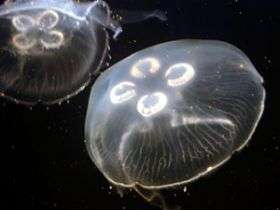Touching research: To improve robots, researcher eyes jellyfish

(PhysOrg.com) -- Biology professor Joseph Ayers is expanding his research on animals’ nervous systems that produced the RoboLobster and RoboLamprey to include a study on tactile sensory perception in jellyfish and lobsters.
In the dark, underwater robots must rely on tactile and hydrodynamic senses and tentacles and antennae are the sensors of choice. Ayers hopes to create autonomous, biomimetic underwater robotic models that emulate the animals’ nervous systems using a new electronic nervous systems (ENS) controller.
“There are hardly any autonomous robots out there that can operate in unpredictable environments,” Ayers said. “What we bring is a really good understanding of how the nervous system controls behavior in animal models. If we can build a truly biomimetic robot, it will embody the results of four million years of evolution.”
In collaboration with Martin Poitzsch and Matt Sullivan of the Schlumberger-Doll Sensor Physics Group, a division that conducts basic research for technological innovations, Kazuo Mori, a new postdoctoral researcher at Northeastern’s Marine Science Center, and with the help of Warren Gibbons, an expert on jellyfish cultivation procedures, Ayers is constructing a jellyfish culture laboratory at the Nahant center.
Ayers is interested in comparing tactile sensing in the soft, bendable tentacles of jellyfish with that of the more rigid antennae of lobsters.
Whereas lobsters appear to use a centralized sensing system, one mediated by central ganglia, or separate mini-brains in the claws, legs, or tail segments, jellyfish apparently perceive the environment using a different neural organization scheme.
“The sensing systems in lobsters and jellyfish are different,” Ayers said, “and we’re trying to determine how their tactile and hydrodynamic mechanisms differ. By comparing them, we’ll gain insight we could not get by looking at only one of them.”
The sensory neurons in jellyfish, Ayers said, are distributed in a neural net that spreads throughout its tentacles and the local circuits on its tentacles are perhaps independent of, but modulated by the animals’ central brain. The idea is to determine how much local processing occurs on the peripheral nervous system on the tentacles.
With Gibbons’ expertise, Ayers is growing both a polyp and medusa form of the jellyfish. When treated with iodine, Ayers said, the medusae form buds off the polyp in a process called strobulation—a non-sexual form of reproduction that produces free-swimming jellyfish, known as medusae. Ayers will be able to use the neurobiological knowledge gained from comparing the control of the tentacles in the polyp and medusa form in open-loop conditions (with no feedback from the environment) to establish the neuronal circuits that control the tentacles. The robotic models based on these networks will test hypotheses of mechanisms of operation of the animals’ nervous system under closed loop conditions.
“The research we are doing is aimed at producing a novel tactile sensor for robots that operates through the control principals of lobsters and jellyfish,” Ayers said. “We use the experimental evidence from the animal model to inform the development of the electronic model. It’s a simulation of how we think animals’ nervous systems work.”
With funding from the Defense Advanced Research Projects Agency (DARPA), a research and development organization for the Department of Defense, and in collaboration with Nikolai Rulkov of Information Systems Laboratories in San Diego, Ayers, associate professor of engineering David Brady, and Anthony Westphal, a graduate student, are also rebuilding his RoboLamprey with a new electronic nervous system. Previous incarnations of the lobster and lamprey, designed to search for mines in the ocean, were based on finite state machine based controllers, which limited the robots’ effectiveness in unpredictable environments.
“We discovered that unless you completely anticipate and program every situation the robot might be in,” Ayers said, “it gets stuck. We realized that animals never get stuck, but what they do is go into chaotic patterns of control.”
In a recent study titled “Controlling Biomimetic Underwater Robots with Electronic Nervous Systems” from the book “Biomechanisms of Swimming and Flying,” Ayers said the new electronic nervous systems “allow one to replicate in great detail the real behavior of the neurobiological system and … provide a link between the control functions and the experimental measurements from the animal.”
Ayers stressed that a successful robot model of an animal would not be completely autonomous, but rather operate under the constraints of supervised reactive autonomy.
“If I’m walking a dog on the beach and I throw a ball in the water, the dog swims out and comes back,” Ayers said. “I am the supervisor; I give the robot a goal and the dog as a robot uses reactive autonomy to get it without me telling it what to do. The hard part is that we want them to operate in unpredictable circumstances where we can’t see them, but nobody wants a robot that’s completely autonomous so supervisory control is essential.”
While Ayers said one possible application of the RoboLobster or RoboLamprey is neutralizing mines in the surf zone (he said there are about 100 million active mines deployed worldwide, many of which end up in waterways due to erosion), there is also a compelling need to build a robotic platform that can be useful in complex environments such as streams and rivers.
“Animals have evolved to occupy any environment where you would want to put a robot,” Ayers said. “Our aim is to find a way to solve problems” (ecological or otherwise), using these robots, who can “do things either so boring that a human would die of boredom from doing, or so dangerous that you don’t want a human doing it.”
Source: By Jason Kornwitz, Northeastern University

















